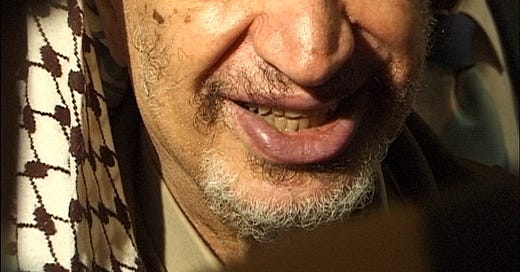I want to be sure everyone has time to do the reading this week, so forgive me if I send this with a typo or two. The book I hoped to assign, Still Life with Bombers, by David Horovitz, doesn’t seem to be available online anywhere. I’ll keep looking. If I can’t find it, I guess we’ll skip it, but it would be a shame.1
I’ve asked Judith to send me the manuscript she wrote about living through the Second Intifada. As soon as she does, I’ll put it in our Google Drive.
Meanwhile, I’m going to assign a bit more reading than you’ll have time to do, probably, but I suggest this: Your goal is to be familiar with the events in the timeline and to be able to answer the study questions. Have a look at everything, then decide what you find helpful to read in doing that. There’s no need to read every page for its own sake; the point is to understand these events. Please also have a look at the articles and documents to which I’ve linked in the timeline.
The Second Intifada: Background and Causes of the Israeli-Palestinian Conflict, by Jeremy Pressman. It was written in 2003. We’ve learned a lot since then from memoirs and other reporting. I don’t fully agree with his analysis, but some of his ideas are interesting, and he gives a good overture of the literature.
The Second Palestinian Intifada: A good discussion of how the IDF tried to contain the violence.
Erased in a Moment: Suicide bombing attacks against Israeli civilians.
The Second Intifada: Israeli society terrorized.
The Implications of the Second Intifada on Israeli Views of Oslo
The Origins of Hamas: Between Islamism and Armed Struggle. This is an eight part series, and you should read it all, but not necessarily this week. This week, just have a look at 3, 7, 8, and any other part that interests you.
Egoistic martyrdom and Hamas’ success in the 2005 municipal elections: A study of Hamas martyrs’ ethical wills, biographies, and eulogies
Targeted Killings and Compellence: Lessons from the Campaign against Hamas in the Second Intifada. Start on p. 19 unless you’re interested in the theoretical discussion.
In a Ruined Country: How Yasir Arafat destroyed Palestine, by David Samuels. This is the best article about Arafat I’ve ever read. It’s paywalled, but even if you don’t subscribe, you can read it as a trial article. If you’ve already used your free trial, here’s a plain text file.
Still grappling with the 2nd Intifada’s legacy: 23 years since the Second Intifada, deep resentment still exists between Israelis and Arabs living in the Palestinian territories.
There are many memoirs that treat the doomed Camp David summit. I haven’t read them all, but I’m sure they’re all interesting in their own right. (Even those that aren’t well written are still of historical interest: It’s always interesting to try to figure out who’s telling the truth, and why the accounts diverge.) If you can get your hands on Clinton’s autobiography, that’s a good account.
Pop Quiz
That correction was appended to the bottom of this article in the Washington Post. Here’s what it originally said:
It’s a glaring mistake. And a revealing one. What it tells us is that neither the reporter, Karen DeYoung, nor any of the editors or proofreaders who worked on this article knows enough about the history of this conflict to be writing about it. My students wouldn’t make that mistake.
Remember, this isn’t just the reporter’s mistake: I would guess that at least three editors signed off on it: a copy editor, certainly, probably an international news editor, and maybe the editor-in-chief, or the deputy editor-in-chief. None of them caught that.
But there’s another major historical error in this article. It hasn’t been corrected. It’s a howler, and it’s even more significant.
I’ll let you tell me what it is in the comments.
Keep reading with a 7-day free trial
Subscribe to The Cosmopolitan Globalist to keep reading this post and get 7 days of free access to the full post archives.







